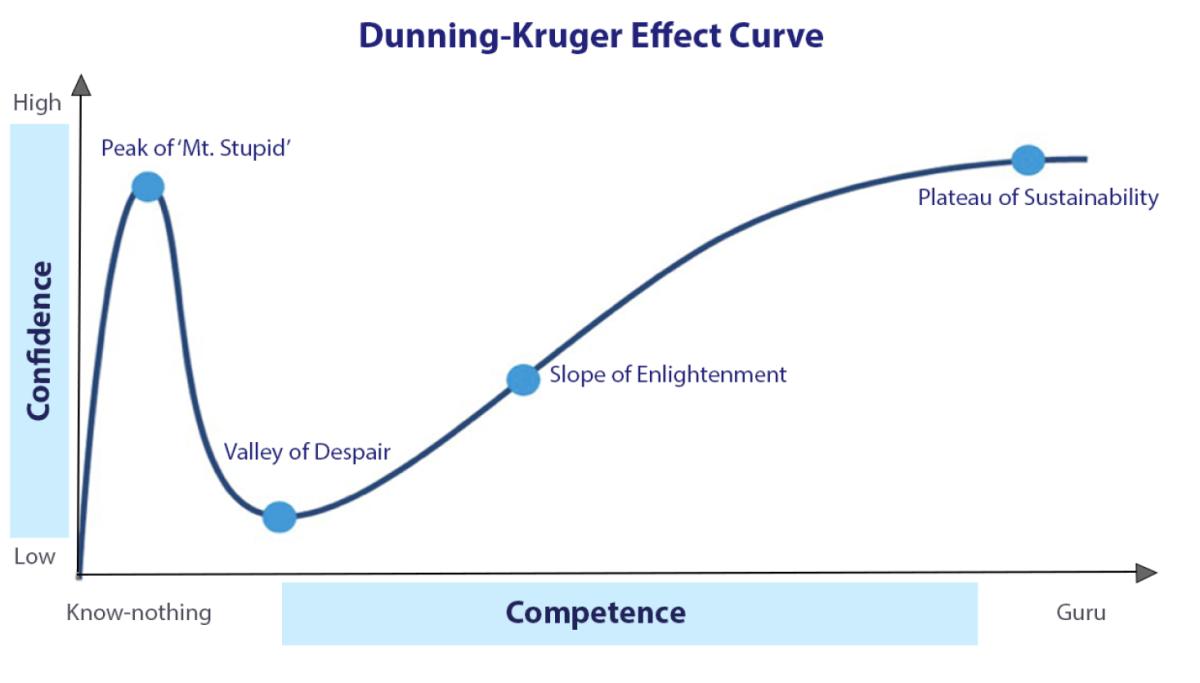Risk of assuming the solution
Learn the risks of assuming the solution, and the value of an outcome focused approach to buying innovation.
The risks of assuming the solution
Some buyers may have experience with, or understand the value of, using an outcome-focused approach to market. However, others might lack knowledge about this crucial stage. They might not be convinced of its benefits, or might be unsure when to use it or where to start.
The risk of locking out innovation
Buyers with the least knowledge often have the highest confidence in their ‘innovation solutioning’ prowess and are the most at risk of reverting to established sourcing solutions that could lock potential innovation out of a tender. Emerging technology enhances this risk, as developments in the market can move faster than even technical experts are aware of.
As buyers gain greater technology solution knowledge and experience, they become more aware of the gaps in their knowledge. As their confidence in pre-determined solutions falls away, they can become more open to innovative possibilities.

Expand the boxes below to understand the impact that assuming a solution could have on the NSW Government and suppliers.
Buyers can have difficulty finding suppliers of innovative products or solutions, especially when the products or solutions do not fit established procurement categories.
Innovators solve problems using novel approaches that buyers may not yet know, understand, or anticipate. An innovative solution might be difficult to compare to known solutions, have broader application than the procurement scope, or exceed requirements set in a tender.
Buyers can make assumptions about a solution to address a superficial problem but, might find it doesn't address the underlying causes. A problem statement approach can help narrow down root causes to articulate the challenge to be solved.
Emerging technology solutions can support additional use cases that a specific buyer might not currently find interesting but could leverage in the future across NSW Government.
The rapid changes in the ICT and digital industry mean that assumed solutions are more likely to become outdated once delivered. This can be true even for technology experts within government. Missing out on the latest market developments makes it challenging for the NSW Government to future-proof its technology investments.
Known 'out of the box' solutions might superficially appear to meet buyer requirements. However, they can end up needing unplanned customisation or having significant integration constraint. Uncovering the changes during or after delivery, once buyers have already invested into the project, can impact cost/benefit.
In 2022, a large group of suppliers of innovative and emerging technology solutions identified lack of two-way communications connecting problems to solutions across NSW Government as a barrier to innovation.
A clear, concise, well-defined problem was cited as an essential component of innovation. It provides suppliers with an understanding of business and users’ needs and affording them the freedom to solve it as they choose.
Emerging technology suppliers stated that they preferred not receiving prescriptive tender specifications and assessment based on a narrow or standard set of criteria of an assumed solution. Rather, they preferred to be asked how well a solution solves a problem.
Attracting the brightest and best innovators is a key objective of the NSW Government so it can build a world class innovation partnership ecosystem.
When buyers overlook suppliers of emerging technology due to assumptions about the end solution, those suppliers take their business to other jurisdictions.
The advantages of focusing on the problem
Adopting an outcome-focus, or focusing on the problem to be solved, has several advantages over assuming a solution. Expand the headings below to learn more.
Inventor of the automobile, Henry Ford, knew that horses were too slow. But this wasn’t really the problem that needed solving.
Ford’s customers thought they needed a faster version of what they already had, but Ford understood their deeper purpose - to get from one place to another faster. This distinction helped him avoid engineering a faster horse and instead opened the doors to engineer something that had never existed before.
Not every idea should be executed. In fact, not every problem needs to be solved. A well-framed problem statement helps determine what should stay on the drawing board.
While emerging technology providers may provide opportunities to modernise, and innovative suppliers heavily market the ‘latest thing’ to potential buyers, these services might not be successful, meaningful, or valued by the business and users. Starting with the problem makes sense.
Buyers, stakeholders, designers, solution providers and users each have a different image in their head of what a solution or product should be. The biggest advantage of framing a problem is the ability to align these views.
Following the practical steps to collect multiple perspectives sparks effective conversations, shared understanding and sound decision making. With a united view and formal sign-off on the ultimate purpose of a solution, the buying process can run more effectively and efficiently.
When the problem is clearly stated at the beginning of a buying project, it helps uncover opportunities for the market to solve challenges. These opportunities might have gone unnoticed had the buying team already assumed a solution and set of specifications.
Because problem statements are rooted in a user’s purpose, they also help move away from assumptions, and see what barriers stand in the way of successfully reaching an end goal.